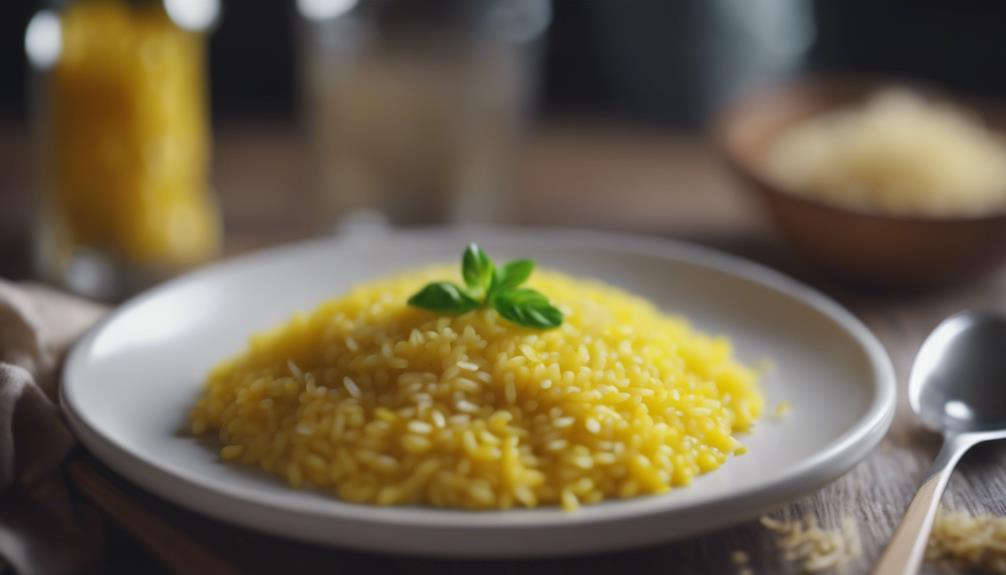Italian cuisine offers a variety of rice-based delights. Treat yourself to creamy Risotto, a velvety dish that absorbs flavorful liquid to perfection. If you’re craving something crispy, try Arancini, Sicilian rice balls bursting with ragù and mozzarella. Indulge in Rice-Stuffed Peppers or hearty Rice-Based Soups for a comforting meal. For a culinary adventure, savor Sicilian Rice Timbale or the Milanese Saffron Risotto Tradition. Finish off with a sweet note with Venetian Rice Pudding or Tuscan Rice Cake. Explore the world of Italian rice dishes for a journey through tantalizing flavors and textures.
Key Takeaways
- Risotto: Creamy and velvety Italian dish made with specific rice varieties.
- Arancini: Sicilian deep-fried rice balls filled with ragù and mozzarella.
- Rice-Based Soups: Minestrone, Risi e Bisi, and Chicken and Rice Soup are popular choices.
- Rice-Stuffed Peppers: Peperoni al Riso filled with savory rice mixture.
- Sicilian Rice Timbale: Baked layers of rice, meat, cheese, and veggies.
Risotto: A Creamy Italian Classic
If you enjoy creamy and indulgent Italian dishes, risotto is a classic that you must try. This delectable dish is a staple in Italian cuisine, known for its rich and velvety texture that comes from specific rice varieties like Arborio, Carnaroli, or Vialone Nano.
Italian risotto has a unique quality of absorbing liquid while releasing starch, resulting in a luxurious consistency that's both comforting and satisfying.
Variations of risotto abound in Italy, with popular renditions including risotto alla milanese, risotto al radicchio, risotto alla certosina, and risi e bisi. Each region in Italy adds its own twist to this beloved dish, showcasing the versatility and creativity of Italian chefs.
The art of making risotto is a culinary tradition that has been perfected over generations, blending traditional flavors with modern techniques to create a diverse range of delicious options.
Arancini: Fried Rice Balls Delight

Arancini, the Sicilian deep-fried rice balls filled with ragù, mozzarella, and peas, are a delightful culinary treat enjoyed worldwide. These golden orbs of goodness originated as humble street food in Sicily but have since gained international fame for their crispy exterior and mouthwatering fillings.
Traditional arancini are coated in breadcrumbs, giving them a satisfying crunch with each bite. The classic combination of savory ragù, gooey mozzarella, and sweet peas creates a flavor explosion that will have your taste buds dancing.
While the traditional recipe remains a favorite, arancini also offer a world of possibilities for experimentation. Variations can include fillings such as ham and cheese, spinach, or even squid ink for a unique twist on this beloved snack.
Whether enjoyed plain or dipped in marinara sauce for an extra burst of flavor, arancini are sure to satisfy your cravings for something crispy, cheesy, and utterly delicious. So, why not treat yourself to these fried rice balls of joy and experience a taste of Sicily wherever you are?
Rice-Based Soups in Italian Cuisine

Explore the diverse world of rice-based soups in Italian cuisine, showcasing a comforting and flavorful addition to traditional dishes. When it comes to Italian cuisine, rice-based soups offer a delightful array of flavors and textures that are sure to warm your soul.
Here are some popular rice-based soups you can savor:
- Minestrone: A hearty vegetable soup that often features rice as a key ingredient, adding a delightful chewiness to the mix.
- Risi e Bisi: This Venetian classic combines rice and peas in a simple yet flavorful soup that embodies the essence of Italian cooking.
- Chicken and Rice Soup: A comforting favorite in Italian households, this soup combines tender chicken and rice in a savory broth that warms you from the inside out.
- Regional Varieties: Italian rice soups showcase a variety of regional ingredients and cooking styles, offering a diverse range of flavors that reflect the richness of Italian culinary traditions.
Italian rice soups aren't only delicious but also a nutritious choice for a satisfying meal that celebrates the essence of Italian comfort food.
Rice-Stuffed Peppers in Italian Cooking

Rice-stuffed peppers, a beloved dish in Italian cuisine, offer a delightful blend of flavors and textures that make them a comforting and satisfying meal option. Known as 'Peperoni al Riso,' these peppers are filled with a savory mixture of rice, herbs, tomatoes, and sometimes meat, creating a delicious and hearty dish. The rice within the peppers acts as a flavor sponge, absorbing the rich tastes of the stuffing and infusing each bite with a mouthwatering essence.
One fantastic aspect of Peperoni al Riso is its versatility. You can tailor the ingredients and seasonings to your liking, making each batch a unique culinary adventure.
This traditional Italian comfort food is cherished for its robust flavors and filling nature. Whether enjoyed as a main course or a side dish, rice-stuffed peppers are sure to please your taste buds and provide a satisfying dining experience.
Sicilian Rice Timbale Recipe

You're about to start on a flavorful journey with the Sicilian Rice Timbale recipe.
This traditional Italian dish showcases layers of rice, meat, cheese, and veggies baked to perfection in a dome shape.
Get ready to savor the creamy texture and rich taste of this savory delight!
Ingredients for Timbale
For the Sicilian Rice Timbale recipe, commonly used ingredients include rice, meat, cheese, and vegetables, creating a flavorful and visually appealing dish. When preparing this traditional Sicilian dish, you can expect a delightful blend of flavors and textures that come together beautifully in each bite.
Here are some key ingredients that make Timbale a mouthwatering experience:
- Rice: The base of the dish, providing a hearty and comforting foundation for the layers of ingredients.
- Meat: Adds richness and protein to the Timbale, with options like ground beef, sausage, or even diced ham.
- Cheese: Melts into the layers, creating a gooey and delicious binding element that enhances the overall taste.
- Vegetables: From sautéed eggplant to roasted peppers, a variety of vegetables can be incorporated to add depth and color to the dish.
These elements come together in harmony, making Timbale a versatile and satisfying Italian dish suitable for any occasion.
Cooking Instructions
To prepare the Sicilian Rice Timbale, start by preheating your oven to 350°F. This classic Italian dish is a delightful combination of rice, meat, cheese, peas, and hard-boiled eggs layered together to create a flavorful masterpiece.
Begin by cooking the rice until it's al dente, then mix in your favorite cooked meat, peas, cheese, and chopped hard-boiled eggs. Next, grease a mold and layer the rice mixture, pressing it down gently to create a solid base. Continue layering the ingredients until the mold is filled, finishing with a final layer of rice on top.
Once your Sicilian Rice Timbale is assembled, cover it with aluminum foil and bake it in the preheated oven for about 30-40 minutes. This baking process allows the flavors to meld together and sets the layers beautifully.
After baking, let the timbale cool slightly before carefully unmolding it onto a serving platter. Slice into portions and serve this Italian delight to impress your guests with a taste of Sicilian tradition. Enjoy!
Venetian Rice Pudding Dessert

Cooking Arborio rice in milk with sugar, vanilla, and lemon zest creates the traditional creamy Venetian Rice Pudding Dessert known as 'Risi e latte.' This delightful dessert is a staple in Venetian cuisine, offering a comforting and rich treat that's perfect for festive occasions and special gatherings.
Here are a few reasons why you should indulge in this delectable dish:
- Creamy Delight: The combination of Arborio rice, milk, sugar, vanilla, and lemon zest results in a velvety smooth texture that melts in your mouth.
- Sweet Sensation: Topped with cinnamon or fruit compote, this dessert offers a perfect balance of sweetness and fruity flavors.
- Traditional Charm: 'Risi e latte' embodies the essence of Venetian culinary traditions, bringing a taste of Italy to your table.
- Versatile Enjoyment: Whether served warm or chilled, this rice pudding dessert is a versatile treat that can be enjoyed year-round.
Indulge in a bowl of Venetian Rice Pudding Dessert to experience the heartwarming flavors of Italy in every bite.
Roman Rice Croquettes Dish

So, you're ready to whip up some Roman Rice Croquettes, huh?
Well, get ready to embrace a delightful combination of ragù, mozzarella, and peas all encased in crispy goodness.
These croquettes are deep-fried to perfection, resulting in a mouthwatering treat that will have you coming back for more!
Ingredients for Croquettes
For the Roman Rice Croquettes dish, gather Arborio rice, tomato sauce, mozzarella cheese, and breadcrumbs as the key ingredients. These elements come together to create a delightful culinary experience that encapsulates the essence of Italian street food.
To make your Roman Rice Croquettes truly authentic, make sure you have the following:
- Arborio Rice: Known for its creamy texture and ability to absorb flavors well, Arborio rice is the perfect base for your croquettes.
- Tomato Sauce: A tangy and rich tomato sauce adds a burst of flavor to the croquettes, enhancing the overall taste profile.
- Mozzarella Cheese: The gooey and stretchy mozzarella cheese not only adds a cheesy goodness but also gives the croquettes their signature 'telephone wire' effect.
- Breadcrumbs: Coating the croquettes with breadcrumbs before frying creates a crispy outer layer that contrasts beautifully with the creamy rice filling.
These ingredients, when combined skillfully, will result in Roman Rice Croquettes that are crispy on the outside, creamy on the inside, and bursting with Italian flavors.
Cooking Instructions for Croquettes
To create the delectable Roman Rice Croquettes dish, begin by preparing the creamy rice and cheese mixture. Start by cooking the rice until it's tender, then mix it with a generous amount of grated Parmesan cheese, a sprinkle of nutmeg, and some finely chopped parsley for that burst of flavor.
Don't forget to add a handful of peas to bring a touch of sweetness and color to the mix. Once you have your creamy rice and cheese mixture ready, shape it into small cylinders or balls, coating each one in breadcrumbs for that satisfying crunch.
Heat up some oil in a pan and fry the croquettes until they turn a beautiful golden brown on all sides. Serve these crispy delights hot and watch them disappear in no time – your guests won't be able to resist the creamy, cheesy goodness that oozes out with each bite.
Enjoy your homemade Roman Rice Croquettes!
Milanese Saffron Risotto Tradition

Explore the rich culinary heritage of Milan with the traditional dish of Milanese saffron risotto. This Italian style rice dish is a true gem that showcases the flavors of the region.
Here are some highlights to help you savor the experience:
- Creamy Arborio rice: The heart of Milanese saffron risotto, this short-grain rice becomes velvety when cooked, creating a luxurious texture.
- Infused with saffron threads: The delicate yet vibrant saffron threads not only give the dish its iconic yellow hue but also add a subtle floral taste.
- Parmesan cheese and butter: These ingredients are often added to enhance the richness of the risotto, offering a salty and creamy balance to the saffron.
- Culinary masterpiece: Milanese saffron risotto is a beloved Italian classic that embodies the essence of Milan's culinary traditions, making it a must-try for any food enthusiast.
Tuscan Rice Cake Dessert

What makes Tuscan rice cake dessert, known as 'Torta di Riso,' a beloved traditional Italian sweet treat? This delightful dessert captivates taste buds with its unique blend of flavors and textures. The combination of rice, candied citron, vanilla, and amaretti biscuits creates a harmonious symphony of sweet and citrusy notes that make Torta di Riso a standout in Tuscan cuisine.
To help you appreciate this delicious dessert even more, here's a breakdown of the key ingredients used in Torta di Riso:
| Ingredients | Description |
|---|---|
| Rice | Provides a soft and creamy texture. |
| Candied Citron | Adds a delightful citrusy flavor. |
| Vanilla | Enhances the overall sweetness. |
| Amaretti Biscuits | Contributes a crunchy element. |
Indulge in the rich history and flavors of Tuscan cuisine with a slice of Torta di Riso. It's a true indication of Italian culinary creativity and regional traditions that will leave you craving more.
Rice Salad: A Refreshing Italian Side

In search of something light and invigorating to complement your meal?
Explore the delicious world of Italian rice salad. This revitalizing side dish combines cooked rice, vibrant veggies, and zesty dressing for a delightful culinary experience.
Whether you serve it cold or at room temperature, Italian rice salad is sure to be a hit at any gathering.
Ingredients for Rice Salad
For a classic Italian rice salad, gather your cooked rice and an assortment of colorful vegetables like bell peppers, cucumbers, and tomatoes.
Adding protein like tuna, hard-boiled eggs, or grilled chicken can make it a more satisfying meal.
To elevate the flavors, consider incorporating herbs such as parsley, basil, or mint for a revitalizing taste.
Dress your rice salad with a vinaigrette or a creamy mayonnaise-based dressing to add a burst of flavor and moisture.
Preparation Methods for Rice Salad
To prepare an invigorating Italian side dish of rice salad, start by gathering all your ingredients and a large mixing bowl. Begin by cooking your rice until it's tender yet firm, then let it cool completely.
In the meantime, chop up your favorite vegetables like bell peppers, cucumbers, and cherry tomatoes. Feel free to add protein such as canned tuna or leftover grilled chicken to make it heartier. Once your rice is ready and your veggies and proteins are prepped, combine them in the mixing bowl.
Don't forget to toss in some flavorful additions like olives, sun-dried tomatoes, and a generous drizzle of olive oil for that authentic Mediterranean taste.
When it comes to dressing, you can go for a classic vinaigrette or mix things up with a creamy dressing for a richer flavor profile. Add your dressing to the salad and gently mix everything together until well combined.
Serving Suggestions for Rice Salad
Looking to elevate the experience of enjoying your invigorating Italian rice salad even further? Here are some serving suggestions that will take your dish to the next level:
- Pair it with a crisp white wine: The crisp acidity of a Pinot Grigio or a light Sauvignon Blanc can beautifully complement the flavors of your rice salad.
- Serve alongside grilled seafood: Grilled shrimp or lemon-infused grilled fish can add a delightful touch of seafood essence to your salad.
- Top with fresh herbs: Sprinkle some freshly chopped basil or parsley over your rice salad for a burst of herbaceous freshness.
- Add a side of crusty bread: A side of warm, crusty bread can help you soak up all the delicious dressing and flavors from your rice salad.
Learn how your guests will comment on the vibrant colors and enticing aromas as they dig into this delightful dish. These serving suggestions will surely enhance the overall dining experience and leave everyone craving for more of your flavorful Italian rice salad.
Frequently Asked Questions
What Is the Common Italian Rice Dish?
When it comes to common Italian rice dishes, risotto stands out for its creamy texture and rich flavors. You'll find this dish showcased in many Italian restaurants, loved for its versatility and delicious taste.
What Is Rice Used for in Italy?
In Italy, rice serves as a versatile canvas for creating creamy risottos, flavorful arancini, and sweet frittelle di riso. It absorbs regional flavors and showcases Italy's culinary diversity through traditional dishes like risi e bisi.
What Is the Italian Food That Looks Like Rice?
If you're wondering what Italian food resembles rice, arancini is the answer. These crispy rice balls are a Sicilian delicacy filled with ragù, mozzarella, and peas. They offer a burst of flavors in every bite.
What Is the Famous Rice Dish?
You're craving something creamy and rich, a classic Italian rice dish that captivates with its flavors and textures. Risotto, with Arborio, Carnaroli, or Vialone Nano rice, shines in regions like Lombardy, Veneto, and Piedmont.
Which of the 10 Most Popular Italian Dishes Use Rice as an Ingredient?
Risotto is one of the most popular Italian dishes that uses rice as a main ingredient. This creamy and flavorful dish can be made with a variety of ingredients such as mushrooms, seafood, or truffles, making it a versatile and delicious Italian staple.
Conclusion
In the world of Italian cuisine, rice takes on many delicious forms, from creamy risotto to crispy arancini.
Like a symphony of flavors, each dish brings a unique melody to the table, creating a culinary masterpiece that's sure to delight your taste buds.
So next time you're craving a taste of Italy, don't forget about the humble rice – it's versatile, flavorful, and always ready to steal the show.
Buon appetito!









